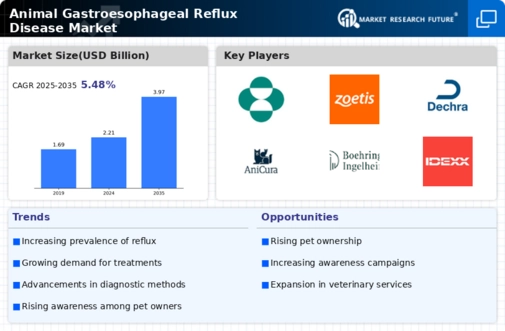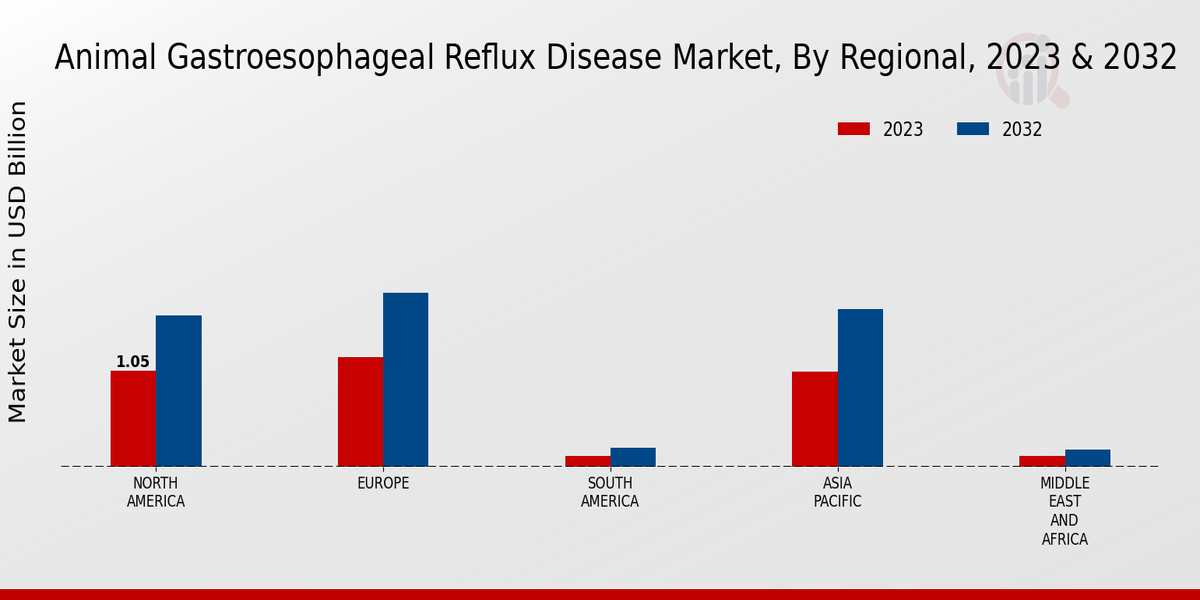Market Growth Projections
The Global Animal Gastroesophageal Reflux Disease Market Industry is projected to experience substantial growth over the coming years. With a market value of 2.21 USD Billion in 2024, it is expected to reach 3.97 USD Billion by 2035, indicating a robust trajectory. The compound annual growth rate (CAGR) of 5.46% from 2025 to 2035 further emphasizes the market's potential. This growth is driven by various factors, including increased awareness of animal health, advancements in veterinary medicine, and rising pet ownership. These projections suggest a promising future for the industry, highlighting the importance of addressing gastroesophageal reflux disease in animals.
Rising Pet Ownership and Spending
The increasing trend of pet ownership globally, coupled with rising expenditures on pet healthcare, is a significant driver for the Global Animal Gastroesophageal Reflux Disease Market Industry. As more households adopt pets, particularly in urban areas, the demand for veterinary services escalates. Pet owners are increasingly willing to invest in their pets' health, leading to higher spending on treatments for conditions like gastroesophageal reflux disease. This trend is expected to sustain a compound annual growth rate (CAGR) of 5.46% from 2025 to 2035, reflecting a robust market potential as pet owners prioritize their animals' well-being.
Advancements in Veterinary Medicine
Innovations in veterinary medicine, including diagnostic tools and treatment options, are propelling the Global Animal Gastroesophageal Reflux Disease Market Industry forward. Enhanced imaging techniques, such as endoscopy, allow for more accurate diagnoses, while novel pharmacological treatments improve management outcomes. These advancements not only facilitate better care but also encourage pet owners to pursue veterinary assistance for their animals. As a result, the market is expected to grow significantly, with projections indicating a value of 3.97 USD Billion by 2035. This growth underscores the importance of continued investment in veterinary research and technology.
Growing Awareness of Animal Health Issues
There is a notable increase in awareness regarding animal health issues, including gastroesophageal reflux disease, which is driving the Global Animal Gastroesophageal Reflux Disease Market Industry. Educational campaigns by veterinary associations and animal welfare organizations are informing pet owners about the symptoms and risks associated with this condition. This heightened awareness encourages early diagnosis and treatment, which can significantly improve animal health outcomes. As more pet owners recognize the importance of addressing gastroesophageal reflux disease, the market is likely to expand, reflecting a shift towards proactive pet healthcare.
Regulatory Support for Animal Health Products
Regulatory bodies are increasingly supporting the development and approval of animal health products, which is beneficial for the Global Animal Gastroesophageal Reflux Disease Market Industry. Streamlined approval processes for new medications and treatments enhance market entry for innovative solutions. This regulatory environment fosters competition and encourages pharmaceutical companies to invest in research and development for gastroesophageal reflux disease treatments. As a result, the market is poised for growth, with an anticipated increase in product availability and diversity, ultimately benefiting animal health and welfare.
Increasing Prevalence of Gastroesophageal Reflux Disease in Animals
The rising incidence of gastroesophageal reflux disease among various animal species is a primary driver for the Global Animal Gastroesophageal Reflux Disease Market Industry. Factors such as dietary changes, obesity, and genetic predispositions contribute to this trend. For instance, studies indicate that certain breeds of dogs and cats are more susceptible to this condition, leading to increased veterinary consultations. As awareness grows, pet owners are more likely to seek treatment, thereby expanding the market. The market is projected to reach 2.21 USD Billion in 2024, highlighting the urgency of addressing this health issue in the animal population.









